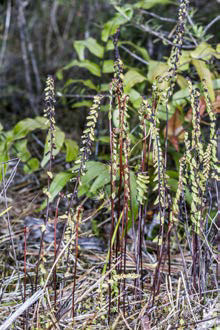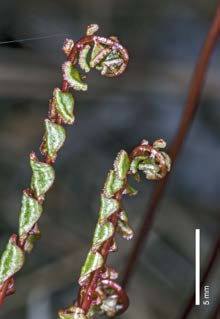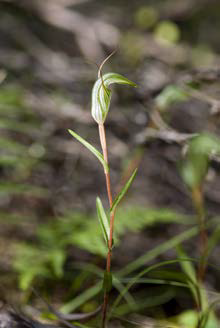Trip Report – 4 May 2013: Taita Scientific Reserve, Lower Hutt
 |
 |
| Two views of Lindsaea linearis. Photos: Jeremy Rolfe. |
We met at the picnic area with a lone mature totara, in Taita’s industrial area on Eastern Hutt Road. Everyone received a plant list blank, an aerial cadastral photo of the site, introductory pages from Tony Druce’s 1957
“Botanical Survey of an experimental catchment, Taita, NZ – the central catchment at Taita Experimental Station”, and Tony’s map of the site.
We climbed the road serving the house at no. 178, and, at a gate into the north end of the reserve, Paul Blaschke, who had worked in the reserve in the late 1980s – early 1990s, gave us fascinating insights into his work there, the history of the reserve, and its fate following the replacement of the Department of Scientific and Industrial Research (DSIR) by the Crown Research Institutes (CRI). From the 1950s to the early 1990s, the property was the site of DSIR’s Soil Bureau. The Director, Norman Taylor, who chose the site, had sought a bush-clad catchment so that its soils could be compared with soils under pasture. Near the Soil Bureau building was an “out-house” for Botany Division, DSIR. Staff included BotSoccers Tony Druce, Ian Atkinson, Carol West, plus Geoff Kelly. Landcare Research, the new CRI which absorbed the Soil Bureau and Botany Division, did not want to maintain the Taita site, so its staff were made redundant, or left to work elsewhere. The site is now managed by Kapiti-Wellington Area Office, Department of Conservation. The buildings, and the land out to Eastern Hutt Road, are now owned by The Learning Connexion.
We continued up the road, past a side road to a GWRC reservoir, and at the end of a straight stretch of the fire-break / road, we entered shrublands and soon arrived at the well-built fence, in excellent condition, despite being well over 50 years old.
Botanising began apace, as we slowly descended through the shrublands to the track built by Tony Druce and others, still in fine condition, and cleared during a recce the previous week. Here we had morning tea, while Paul examined a steel-pipe structure which he believed once supported some form of DSIR monitoring equipment. We continued to the end of the cleared track, and then dropped steeply to near the floor of the gully. Here were mature hard beech, kiekie, collospermum, filmy ferns, etc. After lunch by a trio of big hard beech, we got down to the creek bed, and botanised both banks, finding a sapling swamp maire, wheki and supplejack. The mature forest community here was in marked contrast to the shrublands above, with their infestation of Spanish heath and pine trees. We climbed out of the valley via a more direct route, to the place where we had crossed the fence in the morning. Among the pleasures were finding the delicate ferns,
Lindsaea trichomanoides and
L. linearis, and the greenhood orchid,
Diplodium alobulum, in flower.
 |
Diplodium alobulum.
Photo: Jeremy Rolfe. |
The April 1994 newsletter includes a report of BotSoc’s previous trip into the reserve, led by Dr Ian Atkinson and John Campbell. “The significance of this reserve is in its fire-free status of 40 years, and every effort must be made to perpetuate this”, wrote Dr Kath Dickinson in her trip report.
Participants : Bev Abbott, Paul Blaschke, Laura De la Rosa, Gavin Dench, Chris Horne (leader / scribe), Rodney Lewington, Grant Roberts, Lea Robertson, Nick Saville, Darea Sherratt, Sunita Singh, Roy Slack, Wynn Udall.

 Site Index
Site Index







 Site Index
Site Index





